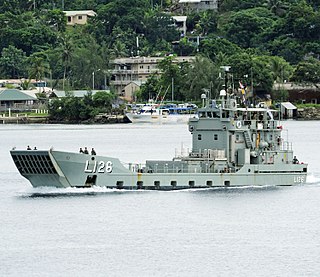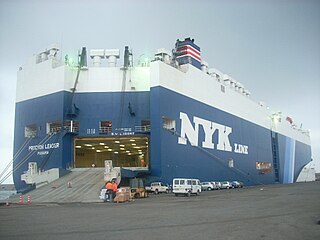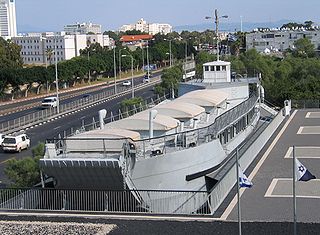
HMAS Balikpapan was the lead ship of the Balikpapan class of heavy landing craft (LCH). Ordered in 1969, Balikpapan entered service with the Australian Army Water Transport Squadron in late 1971. After this, the decision to place all seagoing Army vessels under the control of the Royal Australian Navy (RAN) saw Balikpapan transferred and commissioned in 1974; the last of the eight-vessel class to enter RAN service. Balikpapan was placed in reserve in 1985, but was reactivated three years later. During late 1999 and early 2000, the vessel was part of the INTERFET peacekeeping taskforce, and made additional deployments to East Timor in 2001 and 2006. On 12 December 2012, Balikpapan was retired from RAN service.

High-speed transports were converted destroyers and destroyer escorts used in US Navy amphibious operations in World War II and afterward. They received the US Hull classification symbol APD; "AP" for transport and "D" for destroyer. In 1969, the remaining ships were reclassified as "Fast Amphibious Transports", hull symbol LPR.
HMPNGS Salamaua is a Balikpapan-class heavy landing craft operated by the Papua New Guinea Defence Force (PNGDF). Prior to 1974, the vessel was called HMAS Salamaua and was operated by the Royal Australian Navy (RAN).

Landing craft are small and medium seagoing watercraft, such as boats and barges, used to convey a landing force from the sea to the shore during an amphibious assault. The term excludes landing ships, which are larger. Production of landing craft peaked during World War II, with a significant number of different designs produced in large quantities by the United Kingdom and United States.

Amphibious warfare is a type of offensive military operation that today uses naval ships to project ground and air power onto a hostile or potentially hostile shore at a designated landing beach. Through history the operations were conducted using ship's boats as the primary method of delivering troops to shore. Since the Gallipoli Campaign, specialised watercraft were increasingly designed for landing troops, material and vehicles, including by landing craft and for insertion of commandos, by fast patrol boats, zodiacs and from mini-submersibles. The term amphibious first emerged in the United Kingdom and the United States during the 1930s with introduction of vehicles such as Vickers-Carden-Loyd Light Amphibious Tank or the Landing Vehicle Tracked.

The landing craft, tank (LCT) was an amphibious assault craft for landing tanks on beachheads. They were initially developed by the Royal Navy and later by the United States Navy during World War II in a series of versions. Initially known as the "tank landing craft" (TLC) by the British, they later adopted the U.S. nomenclature "landing craft, tank" (LCT). The United States continued to build LCTs post-war, and used them under different designations in the Korean and Vietnam Wars.

Landing Ship, Tank (LST), or tank landing ship, is the naval designation for ships first developed during World War II (1939–1945) to support amphibious operations by carrying tanks, vehicles, cargo, and landing troops directly onto a low slope beach with no docks or piers. The shallow draft and bow doors and ramps enabled amphibious assaults on almost any beach. The LST had a highly specialized design that enabled ocean crossings as well as shore groundings. The bow had a large door that could open, deploy a ramp and unload vehicles. The LST had a flat keel that allowed the ship to be beached and stay upright. The twin propellers and rudders had protection from grounding. The LSTs served across the globe during World War II including in the Pacific War and in the European theatre.

Roll-on/roll-off ships are cargo ships designed to carry wheeled cargo, such as cars, motorcycles, trucks, semi-trailer trucks, buses, trailers, and railroad cars, that are driven on and off the ship on their own wheels or using a platform vehicle, such as a self-propelled modular transporter. This is in contrast to lift-on/lift-off (LoLo) vessels, which use a crane to load and unload cargo.

A Landing Craft Utility (LCU) is a type of boat used by amphibious forces to transport equipment and troops to the shore. They are capable of transporting tracked or wheeled vehicles and troops from amphibious assault ships to beachheads or piers.

HMS Forth, pennant number F04 later A187, was a submarine depot ship.

HMAS Labuan (L3501) was a Mark III Tank Landing Ship that served in the Royal Navy during World War II, and with the Royal Australian Navy (RAN) from 1946 until 1951.

A depot ship is an auxiliary ship used as a mobile or fixed base for submarines, destroyers, minesweepers, fast attack craft, landing craft, or other small ships with similarly limited space for maintenance equipment and crew dining, berthing and relaxation. Depot ships may be identified as tenders in American English. Depot ships may be specifically designed for their purpose or be converted from another purpose.

HMAS LST 3022 was a Mark 3 Landing Ship Tank (LST) operated by the Royal Navy during World War II, and the Royal Australian Navy (RAN) from 1946 until 1954.

An amphibious warfare ship is an amphibious vehicle warship employed to land and support ground forces, such as marines, on enemy territory during an amphibious assault.

The Ashland-class dock landing ship were the first class of dock landing ship of the United States Navy. They were built during World War II. A dock landing ship is a form of auxiliary warship designed to support amphibious operations. Eight ships were built for the United States Navy and they remained in US service until the 1960s. Two of the class were sold for export overseas, with one joining the Republic of China Navy and the other the Argentinian Navy. The two transferred ships stayed in service until the 1980s. All eight ships were scrapped.

The motor landing craft (MLC) was a vessel used in the 1920s and 30s. It was specifically designed to deliver a tank to shore and may be considered the predecessor of all Allied landing craft mechanised (LCM). The MLC also saw action in the first year of the Second World War. Its primary purpose was to ferry tanks, troops and stores from ships to shore. The craft derived from discussions of the Landing Craft Committee; the prototype was designed by J. Samuel White of Cowes.

HM LCT 7074 is the last surviving Landing Craft, Tank (LCT) in the UK. LCT 7074 is an amphibious assault ship for landing tanks, other vehicles and troops on beachheads. Built in 1944 by Hawthorn Leslie and Company, Hebburn, the Mark 3 LCT 7074 was part of the 17th LCT Flotilla during Operation Neptune in June 1944.

HMCS Prince Henry was an armed merchant cruiser and a landing ship infantry during World War II for the Royal Canadian Navy. The ship began service as the ocean liner SS Prince Henry for the Canadian National Steamship Company servicing ports along the Canadian British Columbia Coast and cities in the United States Northwest. However, lack of commercial opportunity and the arrival of the Great Depression forced the vessel's owners to send Prince Henry to ply the passenger trade along the North American eastern seaboard. In 1937, the vessel was chartered by Clarke Steamship Company and renamed SS North Star for service in the Caribbean Sea and the Gulf of St. Lawrence. The Clarke Steamship Company purchased the vessel outright in 1938. In 1939, with the outbreak of World War II, North Star was one of the vessels acquired by the Royal Canadian Navy for naval service, which returned the ship to its original name.

LCT 147 is an amphibious assault ship for landing tanks, other vehicles and troops on beachheads. Built in 1941 by Stockton Construction, Thornaby-on-Tees, the Mark 2 LCT 147 took part in the Invasion of North Africa in June 1943. The ship was converted to a Landing Craft Rocket at Portsmouth Dockyard from March through May 1943 and renamed LCT(2)(R) 147.




















